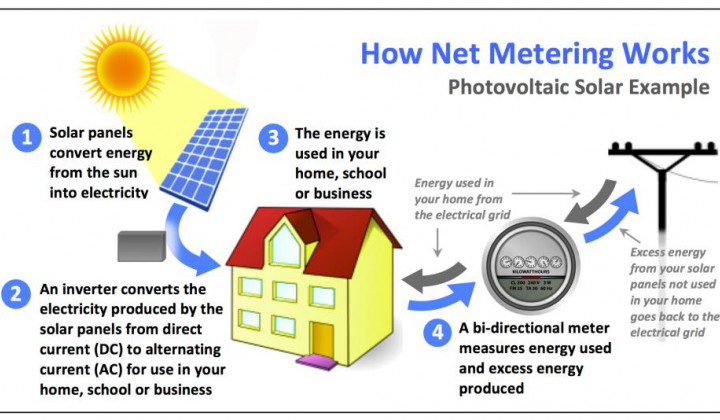Solar Power and Net Metering: Good for Ratepayers

Solar power is creating jobs, diversifying New England’s energy mix, cleaning our air and helping the region fight climate change. Yet many questions have been raised regarding the impact of solar on the electric grid and its fairness to non-solar utility customers and to all ratepayers. We should have a nuanced conversation about equity when discussing any source of energy, but at the end of the day, are solar and net metering—the way we buy and sell distributed energy in almost all of the United States—good for ratepayers? The answer is yes.
Solar benefits ratepayers. A growing body of research shows, more often than not, solar power and net metering (NEM) are net positive for solar and non-solar users:
- A 2015 analysis by the Acadia Center puts the value of solar in Connecticut at 20-25 cents/kWh. This valuation does not include an estimated 9.6 cents/kWh of benefits resulting from avoided pollution, such as carbon, SOx and NOx emissions. A subsequent Acadia Center analysis for Massachusetts puts the value of solar electricity at 22-28 cents/kWh, with additional societal values of 6.7 cents/kWh.
- A 2015 Maine study valued solar at 33 cents per kWh, more than twice the cost of utility power. A 2013 evaluation of net metering in Vermont found NEM does not “impose a significant net cost to ratepayers who are not net metering participants.”
- A 2015 cost-benefit study of net metering in Missouri concluded that the practice is beneficial for all customers, regardless of whether they have rooftop solar or not.The benefits of net metering in Mississippi outweighed the costs in all but one scenario according to a 2014 study. A 2014 study by the Nevada Public Utilities Commission shows that benefits of rooftop solar outweigh the costs. A 2013 study commissioned by the California Public Utilities Commission found that, on average, solar customers on average cover their full costs to the electric grid.
What exactly are the benefits and costs of solar? Sunlight is free, travels fast and requires no extraction. Producing power closer to where it is used eliminates losses along power lines and a distributed network of small-scale power generation can reduce the need for new generation or transmission. Solar prices are stable, eliminating a risk baked into volatile fossil fuel prices. When clean energy reduces demand for oil and gas, it lowers their price, and powering our communities with solar reduces the need to run expensive, dirty generators on hot days. The future is even brighter: in New England, renewable energy can now bid negatively into energy markets, giving solar and wind the ability to reduce wholesale energy costs and further displace fossil fuel use in regions with transmission constraints.
Solar’s costs to the grid may include infrastructure upgrades related to interconnection, new administrative responsibilities and the incentives and credits applied to help finance and encourage uptake of renewable energy projects. For larger (i.e. non-residential projects), developers typically have to pay the entire cost of interconnection, meaning that there is no cost to ratepayers. Some upgrades related to voltage control, metering, etc. may be paid for by the utility (and thus, passed along to ratepayers). Other infrastructure investments—such as replacing old transformers—need to happen whether or not solar is installed and should not be attributed as a cost specific to solar. Overall, distributed generation is critical for modernizing our electric grid, promoting consumer choice, stabilizing costs and keeping energy dollars local.
Net Metering Caps Harm Low-income Consumers, Renters and the Commonwealth
Net metering is capped at a percentage of electric distribution utilities’ peak load, or highest-ever power usage. In Massachusetts, the cap has been hit in the National Grid territory, meaning that in over 170 municipalities, community shared solar (CSS), low-income housing (LIH) solar and all but the smallest commercial projects cannot proceed. Renters, low-income residents and many others rely on these projects to access clean energy. In April 2015, a report by the Massachusetts’ Net Metering and Solar Task Force found that:
“The net metering policy clearly drives the cumulative installations of [virtual net metering, or VNM] LIH and CSS. In capped scenarios neither of these project types will be built, but when net metering is uncapped all 130 scenarios show a hefty fraction of VNM LIH and CSS installs.” (pp. 129-130)
“Availability of net metering incentives is crucial to non-owner participants... This can be explained by the dependence of non-host-owned projects (such as Community Shared Solar and low-income housing with virtual net metering) on the availability of virtual net metering.” (page 132)
In May 2015, Massachusetts has more than 45 MW of solar on the waiting list, which is more solar than was installed during the entire year of 2011. This amount of solar equals $45 million of held up Investment Tax Credit (ITC) funds and $150 million in forgone solar development for solar installers. The Federal ITC expires in 2016.
State Task Force Analysis Confirms Massachusetts Benefits from Solar
Even with added incentives, the Net Metering and Solar Task Force showed that benefits of solar exceed costs, with significant benefits to both solar users and the Commonwealth at large under the existing Solar Renewable Energy Certificate (SREC) program as well as two other simulated incentive models. Looking at the existing incentive structure, the report stated:
“While the SREC programs are expected to come at a net cost to non-participating ratepayers of $2.7-$2.9 billion over 25 years, these programs are also expected to provide $7.0-$8.8 billion in net benefits to the citizens of Massachusetts over the same period, depending on the scenario analyzed. Customer-generators and non-owner participants are likely to enjoy a net benefit ranging from $2.2-$3.8 billion and $734-$809 million, respectively.” (Page 128)
The positive and significant benefit:cost ratio is particularly important to understand as utilities have made claims that solar will cost Massachusetts ratepayers $2-4 billion over the next decade, without factoring in any of the benefits to the Commonwealth at large. If they exist, direct bill impacts to ratepayers are negligibleand can be addressed through rate design changes which more accurately link energy supply and demand.
Solar Works for All Communities. The cost of solar and solar panels is falling rapidly with rooftop solar experiencing an 80% price drop since 2008. Virtual net metering and community shared solar projects enable renters and low-income communities to access solar energy, even if they cannot put solar on their roofs. A 2013 analysis conducted by the Center for American Progress revealed that rooftop solar is not just being adopted by the wealthy; it is, in fact, mostly being deployed in neighborhoods where median income ranges from $30,000 to $90,000. An initial analysis of Massachusetts data shows that 60% of solar systems are deployed in communities with median incomes at or below $80,000. This does not include shared solar or virtually net-metered projects.
So Why are Utilities Waging War on Solar? Despite solar’s clear benefits to communities, investor-owned utility companies continue to assert that solar and net metering raise electricity rates and benefit only the lucky few. These claims are misguided and, worse, often targeted to manipulate communities who have borne the brunt of the fossil fuel economy. An analysis from the Lawrence Berkeley National Laboratory (LBNL) found that even the most aggressive net-metering solar programs would have minimal (0.1-2.7%) impact on electricity rates, but their impact on utility shareholders “may be significantly pronounced.”
Solar has profound effects on the utility business model. Distribution utilities currently anticipate certain revenue through distribution charges, and profit primarily through investments in distribution infrastructure or new transmission. Payments to solar by distribution companies compensate for the benefits provided to the grid. However, such payments represent a loss of revenue to distribution companies that is ultimately recovered from ratepayers. As such, distribution companies tend to unfairly characterize solar compensation as a transfer of revenue from non-solar ratepayers to solar ratepayers.
How Can Solar Move Forward? Solar is working for Massachusetts, with each of the $2.37 billion invested in the state between 2010 and 2014 yielding $1.2 or greater in benefits. Limits on solar such as net metering caps inhibit industry growth and reduce equity in access to clean power. The state should lift net metering caps immediately to prevent further harm. As the industry matures, it may be reasonable to reduce incentives while targeting subsidies to meet specific policy goals, e.g. ensuring grid reliability and providing low-income rate relief. Conducting a comprehensive Value of Solar study, as recommended by the state’s task force, is critical to build consensus among stakeholders. A Value of Solar study should precede any long-term solar policy, which may include substantial regulatory and rate design proceedings.
Download a PDF of this article,with citations, here.


